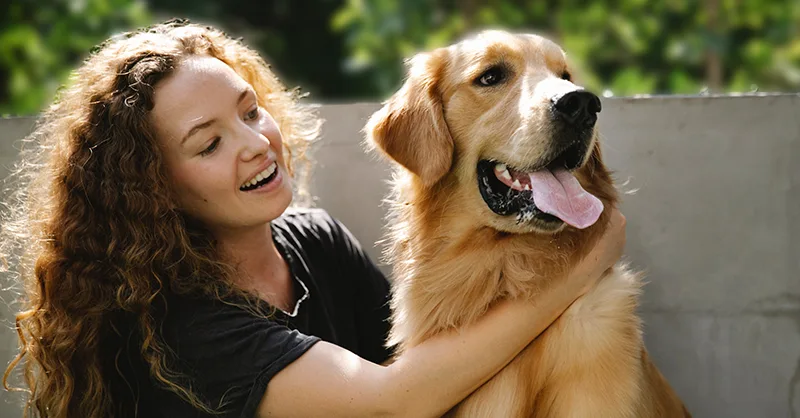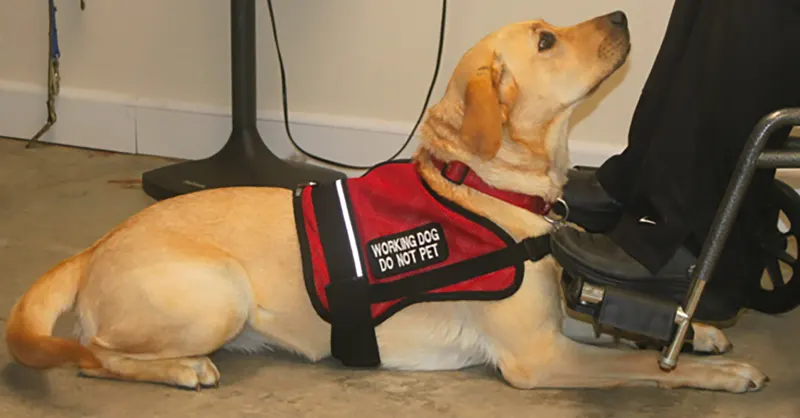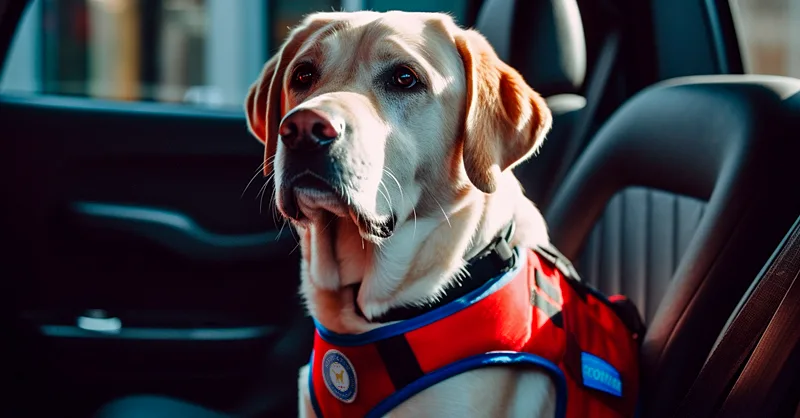Archive for the ‘Service Dog Tips’ Category
Recently, there has been a steep increase in people diagnosed with ADHD (Attention-Deficit/Hyperactivity Disorder). One popular mode of treatment for ADHD is powerful prescription drugs that can have significant stimulatory effects.
Many people, especially parents, have raised concerns about the long-term usage of these pills. They are exploring less chemically reliant methods of addressing ADHD, including cognitive behavioral therapy, diet modification, limiting screen time, and improving sleep habits.
And the question often arises, for individuals with severe ADHD, is the assistance of a service dog another possibility?
Can someone with ADHD have a service dog?To qualify for a service dog, a person’s health condition must be an eligible ADA disability. In the case of ADHD, the condition is so severe it substantially limits their ability to participate in major life activities.
Most people with mild ADHD who can manage their symptoms will not qualify for a service dog. However, those with severe ADHD may qualify if they also require the assistance of a trained service dog that directly helps with their condition.
What tasks can an ADHD service dog perform?ADHD service dogs fall under the type of psychiatric service dogs (PSD). They can perform a variety of tasks for someone with ADHD:
Alerting: Service dogs can be trained to alert their handler when they become distracted or lose focus. The dog can nudge or paw at their handler to redirect their attention back to the task. Deep Pressure Therapy: Service dogs can provide deep pressure therapy by leaning against or laying on their handler when they are feeling overwhelmed or anxious. The pressure can be calming and help regulate the individual’s sensory input. Retrieval: Service dogs can retrieve specific items for their handler, such as medication or a water bottle, to help the individual stay focused. Boundary Setting: Service dogs can create a physical boundary around their handler to prevent them from wandering off or becoming distracted. Interrupting Impulsive Behaviors: Trained service dogs can interrupt impulsive or potentially harmful behaviors, such as skin picking, hair pulling, or reckless driving.As a bonus, service dogs also offer emotional support to their handler by providing a constant source of companionship and unconditional love.
It’s important to note that the tasks a service dog can perform for ADHD may vary depending on the individual’s specific needs and the dog’s training. It’s worth talking to your doctor or therapist about your specific needs and looking into documents like PSD letters to affirm your eligibility.
A service dog provides invaluable assistance to a handler with disabilities by completing specific tasks it was trained for. Owners lead more independent lives, have easier access to places, and may move about with greater confidence, knowing that their trained service animal is there to assist them.
Many tasks that non-disabled people take for granted may simply be out of reach for some disabled individuals, such as picking up dropped objects, safely crossing a city street, or opening a door or elevator.
Service dogs are not pets – at least not in the way that many people think of a pet. The tasks a service animal performs aren’t tricks but rather life-enhancing and sometimes life-saving duties. These are working dogs trained to complete specific tasks and respond to both verbal and non-verbal cues their owners give.
The primary role of a service dog varies; depending on their handlers’ needs, their tasks are different. But in all cases, the service dog is intended to provide assistance for physical or psychological health issues their handler might experience daily.
Service animals are covered by the Americans With Disabilities Act (ADA). They are afforded more access than regular pets or even emotional support animals. In Arizona, service dogs are permitted in the workplace, restaurants, hotels, and airplane cabins.
Disability as Defined by the Americans with Disabilities ActThe ADA offers many protections for individuals with a disability. The term disability is defined as “a physical or mental impairment that substantially limits one or more major life activities.” Discrimination against people with disabilities was much more common before the passage of the ADA, including limited access to public places or public transportation, refusal of service in a restaurant or store, lower pay in the workplace, and discrimination in the hiring process.
The ADA guarantees people with disabilities freedom from discrimination in the workplace, and business places. Furthermore, the ADA ensures reasonable accommodations in stores, at work, and when traveling. Reasonable accommodations could include installing wheelchair ramps in stores and restaurants, providing software that translates text to speech, and allowing a trained service animal to accompany the owner to help them complete specific tasks.
The ADA’s Definition of Service AnimalsThe ADA defines a service dog as “any dog that is individually trained to do work or perform tasks for the benefit of an individual with a disability.” The ADA protects those with both physical and mental or emotional disabilities.
The ADA only legally protects service dogs, explicitly prohibiting any other species of animal, from federal protection.
A service dog is selected for its intelligence, trainability, and temperament. Not every dog is capable of being a service dog, and every service dog will be trained to perform one or more specific tasks. Service dogs are commonly trained to:
guide blind or visually impaired people alert a deaf handler to certain sounds or danger provide non-violent protection retrieve dropped items pull a wheelchair detect the presence of certain allergens, and alert their highly sensitive handler provide support with stability or mobility limitations clear a room for a handler with PTSD, and provide reassurance during panic attacks retrieve medicationThese services are vital for the well-being and safety of the handler. Therefore, the service dog is allowed to remain with their handler at all times.
A fully trained service dog can remain with their handler at all times. Arizona Service Dog RegistrationThe state of Arizona does not require a service dog registration, nor is it mandatory for owners to have specific tags or vests identifying the service dog. The only requirement for a service dog handler is to state that the dog is a service dog and name the tasks it is trained to perform.
However, many service dog handlers find it reassuring to have a service dog registration and accompanying ID card. These items make it easier to navigate in public places and instantly show others that you have a working dog that should not be interfered with.
Arizona Law Protects Service DogsArizona law allows accessibility for a service dog anywhere the owner goes, making discrimination against the owner and dog illegal. Furthermore, the service dog’s actions are protected; people may not interfere with or obstruct the dog’s activity when it’s working. In Arizona, it’s a Class 3 misdemeanor to prohibit access for a service dog.
Your Rights as a Service Dog HandlerYour freedom and rights for employment, housing, and access to public places as a disabled person are guaranteed by the ADA. These civil rights cannot be taken away or restricted, and you are entitled to reasonable accommodation.
Such accommodation includes your service animal, and your word that the dog is a legitimate working animal is enough to grant you and your service dog access to all public places. You do not need to present a service dog certification to exercise your rights.
Although Arizona does not require service dog accessories, most handlers find it easier to provide their dog with a vest to indicate that it’s working and should not be touched or disturbed.
Many also find that registering their service animal with a reputable organization, such as Service Dog Certifications, helps when questioned about the presence of their animal on the premises.
Uber’s policy: Service dogs are allowed to ride with their handlers at no extra cost. According to Uber’s guidelines, drivers are required to accommodate service animals and provide them with the same level of service as any other passenger.
What if your driver gives you a hard time?If an Uber driver refuses to allow your service dog in the car or you face harassment, you can file a complaint with Uber.
To file a report from the Uber Rider App, navigate to the “I Want To Report A Service Animal Issue” screen, available through the trip details screen and the account menu button.
After you file a report, Uber’s team will investigate the incident and act under its Service Animal Policy.
Uber Cleaning FeesYou do not have to pay any additional cleaning fees for hair or shedding from your service dog. If you are charged a cleaning fee after your ride has ended, you can contact Uber to request a refund.
Proving you have a service dogIf the driver wants to verify that you own a service dog, they can ask two questions: 1. Is the dog a service dog required for a disability? and 2. What work or task has the dog been trained to perform?
It can also be helpful to identify your dog as a service animal by carrying an ID card or using accessories like vests and tags. The driver, however, cannot refuse your ride if you do not have these items.
Practical Tips 💡 Make sure the driver is aware that your dog is a service animal so they do not mistakenly believe that it is a pet. Most drivers appreciate it if you keep your service dog on the vehicle’s floor (unless your service dog is needed on your lap or by your side to provide its disability-related service). You are not responsible for cleaning fees for hair or shedding. However, it’s courteous to clean up after your dog whenever possible.






